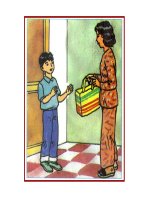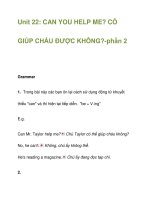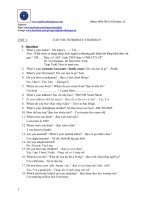Unit 6 can you speak english
Bạn đang xem bản rút gọn của tài liệu. Xem và tải ngay bản đầy đủ của tài liệu tại đây (5.67 MB, 67 trang )
Unit 6 Can you speak English?
Period 1
Period 2
Period 3
Period 4
Period 5
Period 6
Period 7
Period 8
Period 9
Period 10
Period 1+ 2
!
"#
"
Discussion
French today is spoken around the world by 65
to 80 million people as a native language, and by
about 190 to 200 million people as a second or
third language, with significant speakers in 54
countries. Most native speakers of the language
live in France, where the language originated.
Most of the rest live in Canada, Belgium,
Switzerland, Francophone Africa, Luxembourg,
Monaco, or in the United States.
Introduction
Most Spanish speakers are in
Latin America; only Spain is
outside of the Americas. Mexico
has most of the world's native
speakers. Nationally, Spanish is
the official language of Argentina,
Bolivia , Chile, Colombia,
Costa Rica, Cuba,
Dominican Republic, Ecuador,
El Salvador, Guatemala, Honduras
, Mexico , Nicaragua, Panama,
Paraguay , Peru, Uruguay, and
Venezuela. Spanish is also the
official language (co-official with
English) in the U.S. commonwealth
of Puerto Rico.
Spanish or Castilian is an
Indo-European, Romance language
that originated in northern Spain,
and gradually spread in the
Kingdom of Castile and evolved into
the principal language of
government and trade. It was taken
to Africa, the Americas, and
Asia Pacific with the expansion of
the Spanish Empire between the
fifteenth and nineteenth centuries.
Today, between 322 and
400 million people speak Spanish
as a native language, making it the
world's second most-spoken
language by native speakers (after
Mandarin Chinese).
Introduction
$
%
&
'
&()&(
*
#
+
,(
-.
The German language (Deutsch, is a
West Germanic language and one of the
world's major languages. German is
closely related to and classified
alongside English and Dutch. Around the
world, German is spoken by
approximately 100 million
native speakers and also about 80 million
non-native speakers, and
Standard German is widely taught in
schools, universities, and
Goethe Institutes worldwide.
Introduction
$)$
/*
/0 *1
/
/0
1
/,(
/
/
Italian is a
Romance language spoken by about
63 million people as a first language,
primarily in Italy. In Switzerland,
Italian is one of four
official languages. It is also the
official language of San Marino. It is
the primary language of the
Vatican City. Standard Italian,
adopted by the state after the
unification of Italy, is based on
Tuscan (in particular from the
dialects of the cities of Florence, Pisa
and Siena) and is somewhat
intermediate between Italo
-Dalmatian languages of the South
and Northern Italian languages of the
North.
Introduction
/
'
/&(
/%
/(2
/
/3"4
'5
/)&
/-"
/
Portuguese is a Romance language that
originated in what is now Galicia (Spain)
and northern Portugal. It is derived from the
Latin spoken by the romanized
Pre-Roman peoples of the Iberian Peninsul
a
(namely the Gallaeci, the Lusitanians, the
Celtici and the Conii) around 2000 years
ago. It spread worldwide in the 15th and
16th centuries as Portugal established a
colonial and commercial empire (1415–
1999) which spanned from Brazil in the
Americas to Goa and other parts of India
and Macau in China. It was used as the
exclusive lingua franca on the island of
Sri Lanka for almost 350 years.
Introduction
!6
&(
.
078,1
'%
",
'#
'9,
#:
';<=
Japanese is a language spoken by over
130 million people in Japan and in
Japanese emigrant communities. It is
related to the Ryukyuan languages.
There may exist
relationships with other languages, but
they have still remained undemonstrated.
It is an agglutinative language and is
distinguished by a complex system of
honorifics reflecting the hierarchical
nature of Japanese society, with verb
forms and particular vocabulary to
indicate the relative status of speaker,
listener and the third person mentioned in
conversation whether he is there or not.
The sound inventory of Japanese is
relatively small, and it has a lexically
distinct pitch-accent system. It is a mora-
timed language
Introduction
English is a West Germanic
language originating in England
and is the first language for most
people in the United Kingdom,
the United States, Canada,
Australia, New Zealand, Ireland
and the Anglophone Caribbean.
It is used extensively as a second
language and as an official
language throughout the world,
especially in Commonwealth
countries and in many
international organizations.
Which languages can you speak?
Tay language
Chinese
English
French
Russian
Vietnamese
Modal Verb CAN / COULD
7.7
)%9 .>##
###
#7
)#7
)2?7
-+
*
#
"#,##,@
Modal Verb CAN / COULD
7
0A1AA)BA
0 1
-+
A#-#7
A*,#*,C7
Modal Verb CAN / COULD
7
( - ) S + can/ could + not + V - inf + ( O ).
Ex :
+ We can’t use computers .
+ They couldn’t play chess when they were 10 .
Modal Verb CAN / COULD
7
(? ) (Wh ) . can/ could + S + V - inf + ( O ) ?
( Yes , S +can / could . No , S + can / could + not .)
Ex :
+ Where can you go ?
+ What could you do when you were 10 ?
+ Can you make music ?
+ Could you swim when you were 7 ?
Look at the pictures
Look at the pictures
What can they do?
Look at the pictures
Look at the pictures
Look at the pictures
Consolidation
"#
"D
8,
-+0,1
Period 3 + 4
!
"#
"
Match the sentences and
pictures
1. He can ski really well.
2. She can use a
computer.
3. Can dogs swim? Yes,
they can.
4. Can you speak
Japanese? No, I
can’t.
5. I can’t spell your
name.
6. We can’t understand
the questions.
Listen and Check
Listen and Complete the Sentences
<7 *EEEE7*EE77
C7 8E77#EEEE
F7 E77EE7GH*E77
I7 "#EE7#EE7
J7 EE77,EEE7
K7 EE7#E77G9#EE77
Listen to Tina and Complete the Chart
Can she………?????
>
L#
*
'
,
'#
.









